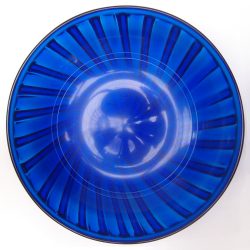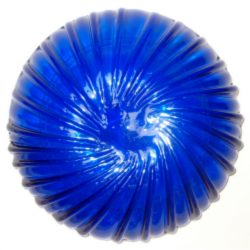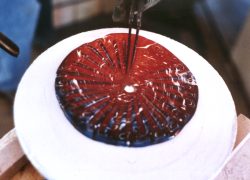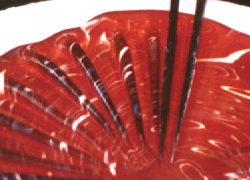

This section of our website deals with our work on ribbed bowls and contains a general introduction, together with links to specific articles.
|
|
Second Gather 2003 Exhibition:
An exhibition with the theme of vertically pinched ribs used as decoration on ancient glass.
|
|
|
|
Mosaic Glass and Ribbed Bowls:
The original version of the article written by us which appeared in Current Archaeology 186 (June/July 2003).
| |
|
|
Ribbed Bowls and their Manufacture:
This is the poster presentation we put together for the AIHV 2003 Congress in London (September 2003).
|
|
|
|
Ribbed Bowls and their Manufacture:
This article is due to be published in the British Museum Catalogue of Glass in the Department of Greek and Roman Studies.
|
|
|
|
Newsletter #:
This Newsletter will contain updates on the techniques we are using to create ribbed bowls. (Not yet on website)
|
 Ribbed bowls had their origins during the late Hellenistic period, appearing as early as the first quarter of the 1st century BC in the excavated finds of sites such as Tel Anafa and Delos. These early bowls were made in colourless, translucent, greenish yellow and golden brown glass. Their likely places of manufacture were the Syro-Palestinian workshops of the eastern Mediterranean.
Ribbed bowls had their origins during the late Hellenistic period, appearing as early as the first quarter of the 1st century BC in the excavated finds of sites such as Tel Anafa and Delos. These early bowls were made in colourless, translucent, greenish yellow and golden brown glass. Their likely places of manufacture were the Syro-Palestinian workshops of the eastern Mediterranean.
The techniques of manufacture continued and developed during Early Imperial times, but the period from the late 1st century BC to the second quarter of the 1st century AD saw the addition of steep-sided monochrome vessels and the appearance of polychrome mosaic vessels.
 Archaeological sites in the eastern Mediterranean have revealed few ribbed bowls dating after 50AD, so it is likely that the abundant finds from Italy and western Europe were products of the western part of the Empire. The monochrome vessels were produced from Tiberian times to the end of the Flavian period, making them one of the last types of 'cast' Roman glass. Their mosaic counterparts are almost exclusively found in Italy and western Europe, and date to the Augustan and Tiberian periods.
Archaeological sites in the eastern Mediterranean have revealed few ribbed bowls dating after 50AD, so it is likely that the abundant finds from Italy and western Europe were products of the western part of the Empire. The monochrome vessels were produced from Tiberian times to the end of the Flavian period, making them one of the last types of 'cast' Roman glass. Their mosaic counterparts are almost exclusively found in Italy and western Europe, and date to the Augustan and Tiberian periods.
The colours of earlier monochrome bowls tend to be strong: purple, dark blue and golden brown, as well as opaque white or blue. Later vessels tend to be pale blue green or light green, particularly after 50AD.

Colours of mosaic ribbed bowls tend also to be purple, dark blue and golden brown, but with opaque white spirals (some angular), multiple opaque white rods, or a combination of rods and concentric circles. Manipulation and stretching during the fusing stage can give the bowl a marbled appearance, especially on the outer surface.
The bowls are ground and polished on the inner surface, the rim, and often on the outer surface in the area between the rim and the tops of the ribs. There are frequently one or two concentric horizontal decorative grooves cut into the inner surface.

At first glance, the ribs on these bowls appear to be uniform and almost identical, but closer inspection reveals inconsistencies of length, thickness and height, together with uneven spacing.
Toolmarks are often visible. The formation of these ribs has for many years been a subject of debate. It is our belief that each rib was individually formed by the technique of 'rib-pinching', which satisfactorily explains all of the features seen on these vessels. This is the method which we employ (see our article in the Catalogue of Ancient Glass in the Greek and Roman Department of the British Museum).